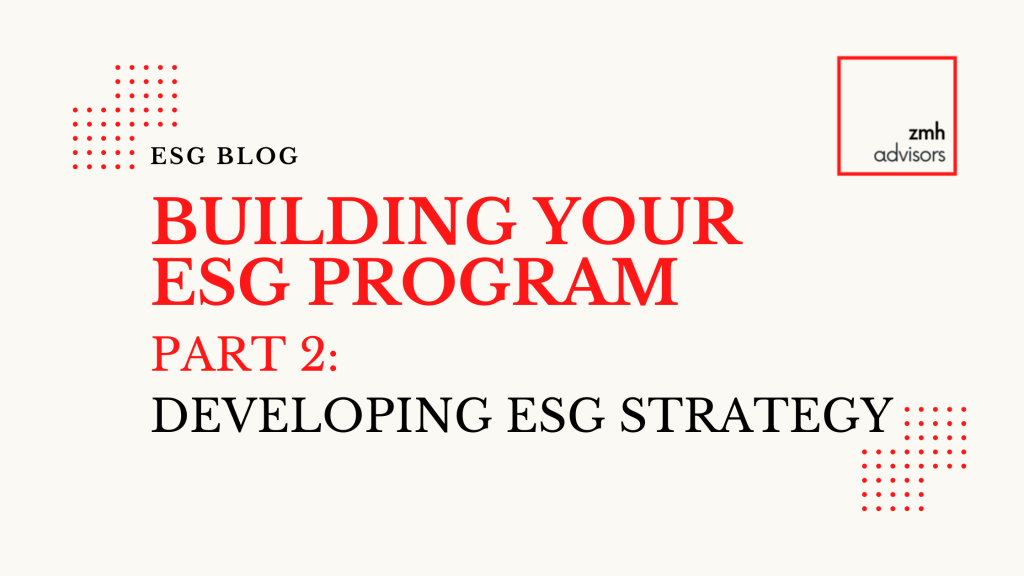Developing ESG Strategy
After you assemble your team to help build your ESG program, your company needs to craft a sustainability strategy. There are many real-world challenges when it comes to developing a strategy, particularly ensuring that it aligns with the company’s overall business plan.
In developing a sustainability strategy, you will need to consider these major drivers:
- Who are our key stakeholders when it comes to ESG?
- What ESG topics are relevant to those stakeholders? And what KPIs are commonly reported for those topics? What should be our metrics and targets so we can best align?
- How should we identify and prioritize our various ESG goals so that they are best integrated with our company’s existing business strategy?
Who Are Our Key Stakeholders?
Your key stakeholders at this point are pretty much everybody. Your investors, regulators, customers, suppliers, employees and the communities in which you operate.
For several years now, nearly all institutional investors have taken up the mantle of ESG, everything from climate to social issues. Each year, the voting policies of these investors are increasingly more proactive in an effort to get management to place a greater emphasis on ESG issues. They are looking for real change. Not a “check the box” attitude.
At many companies, employees are paying greater attention to their employer’s stance towards ESG. Is my company doing the right thing for the environment? Doing the right thing for DEI? Employees take pride in what the company is doing in these areas if they’re doing it right. If they’re not doing it right, morale can suffer. People might decide to find a better fit at another employer.
The same is true with your customers. Is your sustainability footprint attractive to them? Increasingly, customers are asking suppliers to ensure robust ESG compliance, as part of their global sustainability commitments. If you have a compelling ESG strategy, it is important you communicate that to your customers.
And don’t forget about your own supply chain. You are their customer, and their activities impact your sustainability – and vice versa. Many suppliers – and customers – are asking questions of each other about their climate activities as they get ready for possible Scope 3 emissions reporting.
Finally, we have the regulators that are actively moving to implement new regulations that will establish broad disclosure requirements (such as the SEC) as well as regulations that might establish compliance obligations for both climate and social topics. This is happening on a global scale and it’s challenging to keep abreast of all the regulatory developments because they’re happening so fast.
How Should We Identify and Prioritize Our Various ESG Goals So That They Are Best Integrated With Our Company’s Existing Strategy?
Before you can set your ESG strategy, you need to do the homework so that you know what your baseline is right now. This often is much more time-consuming and challenging than you would think.
That’s because the data must come from parts of your business that are not accustomed to reporting out this kind of information. It’s not part of the typical audit trail that is part and parcel of the financial reporting process. And there often is pushback from those asked to participate in collecting the data because they might not see the value in this project. Or feel they have the time to devote to it.
But without a baseline, it’s hard to tell “where to go from here.” So top management really needs to be on board in setting the tone that this is an important job and it’s necessary to the company’s overall business strategy going forward. You need “true believers” to help it go as smooth as possible but note road bumps are likely and should be built into your anticipated timeline.
Once you have this baseline information to help inform top management and the board of directors, they can sit down and ponder what makes the most sense for your particular company. This is not a “one board meeting” type of decision. This is a big deal and could take a while and it is something should be regularly evaluated as time goes on.
What ESG Topics Matter Most to Our Stakeholders? And What Should Be Our Metrics and Targets to Achieve Better Alignment?
When setting your strategy, you should be careful to ensure it is genuine and authentic. Don’t claim something is your strategy because it will sound good from a marketing standpoint. Or because it will check a stakeholder’s box. That can only lead to trouble and may very well land you in court or a regulator’s doghouse. It is important to consider the perspectives of all your stakeholders when you are setting your strategy.
When it comes to your institutional investors, you will want to develop an engagement program where you’re periodically discussing ESG with them. As part of that, you’ll need to be educated about their ESG priorities, the relevant voting policies, and the shareholder proposals they are most likely to support. Investor information changes rapidly so you may need to leverage additional resources to help you consolidate and simplify these vast amounts of data in real time. Note that ZMH’s “ESG Dashboard” allows you to digest the nuances of the investors’ ESG priorities and voting policies at the touch of a button.
You’ll want to know what other companies in your industry are doing. You don’t have to necessarily copy them – but industry standards are likely to develop when it comes to KPIs. When it comes to metrics and targets. You don’t want to be too much of an outlier.
When deciding which metrics and targets to use, you’ll need to consider what type of information you’ll be required to – and want to – publicly disclose. The concept of “materiality” plays into that, and we’ll dig deep into that complex concept too. ZMH Advisors has a materiality assessment service that can assist you with this oftentimes challenging determination.

Posted Date: 01-04-23
